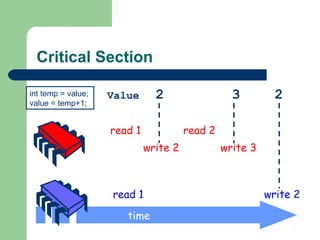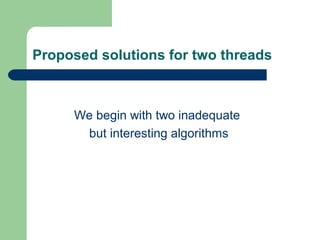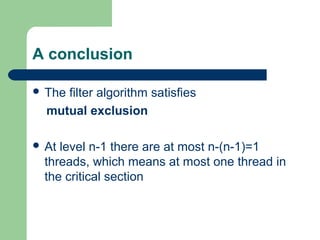The document discusses algorithms for solving the mutual exclusion problem in multithreaded programs. It begins by describing two inadequate algorithms for two threads that fail to guarantee deadlock freedom. It then presents Peterson's algorithm and Kessels' single-writer algorithm, proving they satisfy mutual exclusion, deadlock freedom, and starvation freedom for two threads. The document also discusses using tournament algorithms and the filter algorithm to generalize two-thread solutions to work for multiple threads by having threads progress through levels like a tournament bracket.









![Algorithm 1
Thread 0
flag[0] = true
while (flag[1]) {}
critical section
flag[0]=false
Thread 1
flag[1] = true
while (flag[0]) {}
critical section
flag[1]=false](https://image.slidesharecdn.com/mutualexclusion-140822113340-phpapp02/85/Mutual-exclusion-10-320.jpg)

![Proof
Assume in the contrary that two threads can be in their critical
section at the same time.
From the code we can see:
write0(flag[0]=true) read0(flag[1]==false) CS0
write1(flag[1]=true) read1(flag[0]==false) CS1
From the assumption:
read0(flag[1]==false) write1(flag[1]=true)
Thread 0
flag[0] = true
while (flag[1]) {}
critical section
flag[0]=false
Thread 1
flag[1] = true
while (flag[0]) {}
critical section
flag[1]=false](https://image.slidesharecdn.com/mutualexclusion-140822113340-phpapp02/85/Mutual-exclusion-12-320.jpg)
![Proof
We get:
write0(flag[0]=true) read0(flag[1]==false)
write1(flag[1]=true) read1(flag[0]==false)
That means that thread 0 writes (flag[0]=true) and then thread 1
reads that (flag[0]==false), a contradiction.
Thread 0
flag[0] = true
while (flag[1]) {}
critical section
flag[0]=false
Thread 1
flag[1] = true
while (flag[0]) {}
critical section
flag[1]=false](https://image.slidesharecdn.com/mutualexclusion-140822113340-phpapp02/85/Mutual-exclusion-13-320.jpg)
![Deadlock freedom
Thread 0
flag[0] = true
while (flag[1]) {}
critical section
flag[0]=false
Thread 1
flag[1] = true
while (flag[0]) {}
critical section
flag[1]=false
Algorithm 1 fails dead-lock freedom:
Concurrent execution can deadlock.
If both threads write flag[0]=true and flag[1]=true
before reading (flag[0]) and (flag[1]) then both
threads wait forever.](https://image.slidesharecdn.com/mutualexclusion-140822113340-phpapp02/85/Mutual-exclusion-14-320.jpg)






![Peterson’s Algorithm
Thread 0
flag[0] = true
victim = 0
while (flag[1] and victim == 0)
}skip{
critical section
flag[0] = false
Thread 1
flag[1] = true
victim = 1
while (flag[0] and victim == 1)
}skip{
critical section
flag[1] = false](https://image.slidesharecdn.com/mutualexclusion-140822113340-phpapp02/85/Mutual-exclusion-21-320.jpg)
![Peterson’s Algorithm
0/1 indicates that the thread is contending for the critical
section by setting flag[0]/flag[1] to true.
victim shows who got last
Then if the value of flag[i] is true then there is no contending
by other thread and the thread can start executing the critical
section. Otherwise the first who writes to victim is also the
first to get into the critical section
Thread 0
flag[0] = true
victim = 0
while (flag[1] and
victim == 0) }skip{
critical section
flag[0] = false
Thread 1
flag[1] = true
victim = 1
while (flag[0] and
victim == 1) }skip{
critical section
flag[1] = false](https://image.slidesharecdn.com/mutualexclusion-140822113340-phpapp02/85/Mutual-exclusion-22-320.jpg)
![Schematic for Peterson’s mutual exclusion algorithmSchematic for Peterson’s mutual exclusion algorithm
Indicate contending
flag[i] := true
Indicate contending
flag[i] := true
Barrier
victim := i
Barrier
victim := i
Contention?
flag[j] = true ?
Contention?
flag[j] = true ?
critical sectioncritical section
exit code
flag[i] = false
exit code
flag[i] = false
First to cross
the barrier?
victim = j ?
First to cross
the barrier?
victim = j ?yes
yes
no / maybe
no
The structure shows that the
first thread to cross the barrier is
the one which gets to enter the
critical section. When there is no
contention a thread can enter the
critical section immediately.](https://image.slidesharecdn.com/mutualexclusion-140822113340-phpapp02/85/Mutual-exclusion-23-320.jpg)

![Proof
Assume in the contrary that two threads can be in their
critical section at the same time.
From the code we see:
(*) write0(flag[0]=true) write0(victim=0)
read0(flag[1]) read0(victim) CS0
write1(flag[1]=true) write1(victim=1) read1(flag[0])
read1(victim) CS1
Thread 0
flag[0] = true
victim = 0
while (flag[1] and
victim == 0) }skip{
critical section
flag[0] = false
Thread 1
flag[1] = true
victim = 1
while (flag[0] and
victim == 1) }skip{
critical section
flag[1] = false](https://image.slidesharecdn.com/mutualexclusion-140822113340-phpapp02/85/Mutual-exclusion-25-320.jpg)
![Proof
Assume that the last thread to write to victim was 0. Then:
write1(victim=1) write0(victim=0)
This implies that thread 0 read that victim=0 in equation (*)
Since thread 0 is in the critical section, it must have read
flag[1] as false, so:
write0(victim=0) read0(flag[1]==false)
Thread 0
flag[0] = true
victim = 0
while (flag[1] and
victim == 0) }skip{
critical section
flag[0] = false
Thread 1
flag[1] = true
victim = 1
while (flag[0] and
victim == 1) }skip{
critical section
flag[1] = false](https://image.slidesharecdn.com/mutualexclusion-140822113340-phpapp02/85/Mutual-exclusion-26-320.jpg)
![Proof
Then, we get:
write1(flag[1]=true) write1(victim=1)
write0(victim=0) read0(flag[1]==false)
Thus:
write1(flag[1]=true) read0(flag[1]==false)
There was no other write to flag[1] before the critical
section execution and this yields a contradiction.
Thread 0
flag[0] = true
victim = 0
while (flag[1] and
victim == 0) }skip{
critical section
flag[0] = false
Thread 1
flag[1] = true
victim = 1
while (flag[0] and
victim == 1) }skip{
critical section
flag[1] = false](https://image.slidesharecdn.com/mutualexclusion-140822113340-phpapp02/85/Mutual-exclusion-27-320.jpg)

![Proof
Assume to the contrary that the algorithm is not
starvation-free
Then one of the threads, say thread 0, is forced to
remain in its entry code forever
Thread 0
flag[0] = true
victim = 0
while (flag[1] and
victim == 0) }skip{
critical section
flag[0] = false
Thread 1
flag[1] = true
victim = 1
while (flag[0] and
victim == 1) }skip{
critical section
flag[1] = false](https://image.slidesharecdn.com/mutualexclusion-140822113340-phpapp02/85/Mutual-exclusion-29-320.jpg)
![Proof
This implies that at some later point thread 1 will do
one of the following three things:
1. Stay in its remainder forever
2. Stay in its entry code forever, not succeeding and
proceeding into its critical section
3. Repeatedly enter and exit its critical section
Thread 0
flag[0] = true
victim = 0
while (flag[1] and
victim == 0) }skip{
critical section
flag[0] = false
Thread 1
flag[1] = true
victim = 1
while (flag[0] and
victim == 1) }skip{
critical section
flag[1] = false
We’ll show that each of
the three possible cases
leads to a contradiction.](https://image.slidesharecdn.com/mutualexclusion-140822113340-phpapp02/85/Mutual-exclusion-30-320.jpg)
![Proof
In the first case flag[1] is false, and hence thread 0 can
proceed.
The second case is impossible since victim is either 0 or 1, and
hence it always enables at least one of the threads to proceed.
In the third case, when thread 1 exit its critical section and tries
to enter its critical section again, it will set victim to 1 and will
never change it back to 0, enabling thread 0 to proceed.
Thread 0
flag[0] = true
victim = 0
while (flag[1] and
victim == 0) }skip{
critical section
flag[0] = false
Thread 1
flag[1] = true
victim = 1
while (flag[0] and
victim == 1) }skip{
critical section
flag[1] = false](https://image.slidesharecdn.com/mutualexclusion-140822113340-phpapp02/85/Mutual-exclusion-31-320.jpg)
![Kessels’ single-writer Algorithm
What if we replace the multi-writer register victim with two single-
writer registers. What is new algorithm?
Answer (Kessels’ Alg.)
victim = 0 victim[0] =victim[1]
victim = 1 victim[0] ≠victim[1]](https://image.slidesharecdn.com/mutualexclusion-140822113340-phpapp02/85/Mutual-exclusion-32-320.jpg)
![Kessels’ single-writer Algorithm
Thread 0
flag[0] = true
local[0] = victim[1]
victim[0] = local[0]
while (flag[1] and
local[0]=victim[1]) }skip{
critical section
flag[0] = false
Thread 1
flag[1] = true
local[1]=1-victim[0]
victim[1] = local[1]
while (flag[0] and
local[1] ≠ victim[0])) }skip{
critical section
flag[1] = false
Thread 0 can write the registers victim[0] and flag[0]
and read the registers victim[1] and flag[1]
Thread 1 can write the registers victim[1] and flag[1]
and read the registers victim[0] and flag[0]](https://image.slidesharecdn.com/mutualexclusion-140822113340-phpapp02/85/Mutual-exclusion-33-320.jpg)



![The Filter Algorithm for n Threads
A direct generalization of Peterson’s algorithm
to multiple threads.
The Peterson algorithm used a two-element
boolean flag array to indicate whether a
thread is interested in entering the critical
section. The filter algorithm generalizes this
idea with an N-element integer level array,
where the value of level[i] indicates the latest
level that thread i is interested in entering.
ncs
cslevel n-1](https://image.slidesharecdn.com/mutualexclusion-140822113340-phpapp02/85/Mutual-exclusion-37-320.jpg)

![The Filter Algorithm
Thread i
for (int L = 1; L < n; L++) {
level[i] = L;
victim[L] = i;
while ((∃ k != i level[k] >= L) and victim[L] == i ) {}
}
critical section
level[i] = 0;](https://image.slidesharecdn.com/mutualexclusion-140822113340-phpapp02/85/Mutual-exclusion-39-320.jpg)
![Thread i
for (int L = 1; L < n; L++) {
level[i] = L;
victim[L] = i;
while ((∃ k != i level[k] >= L) and victim[L] == i ) {}
}
critical section
level[i] = 0;
Filter
One level at a time](https://image.slidesharecdn.com/mutualexclusion-140822113340-phpapp02/85/Mutual-exclusion-40-320.jpg)
![Filter
Thread i
for (int L = 1; L < n; L++) {
level[i] = L;
victim[L] = i;
while ((∃ k != i level[k] >= L) and victim[L] == i ) {}
}
critical section
level[i] = 0;
Announce intention to enter level L](https://image.slidesharecdn.com/mutualexclusion-140822113340-phpapp02/85/Mutual-exclusion-41-320.jpg)
![Filter
Thread i
for (int L = 1; L < n; L++) {
level[i] = L;
victim[L] = i;
while ((∃ k != i level[k] >= L) and victim[L] == i ) {}
}
critical section
level[i] = 0;
Give priority to anyone but me (at every level)](https://image.slidesharecdn.com/mutualexclusion-140822113340-phpapp02/85/Mutual-exclusion-42-320.jpg)
![Filter
Thread i
for (int L = 1; L < n; L++) {
level[i] = L;
victim[L] = i;
while ((∃ k != i level[k] >= L) and victim[L] == i ) {}
}
critical section
level[i] = 0;
Wait as long as someone else is at same or higher level,
and I’m designated victim.
Thread enters level L when it completes the loop.](https://image.slidesharecdn.com/mutualexclusion-140822113340-phpapp02/85/Mutual-exclusion-43-320.jpg)
![Claim
There are at most n-L threads enter level L
Proof: by induction on L and by contradiction
At L=0 – trivial
Assume that there are at most n-L+1 threads at level
L-1.
Assume that there are n-L+1 threads at level L
Let A be the last thread to write victim[L] and B any
other thread at level L](https://image.slidesharecdn.com/mutualexclusion-140822113340-phpapp02/85/Mutual-exclusion-44-320.jpg)
![Proof structure
ncs
cs
Assumed to enter L-1
By way of contradiction
all enter L
n-L+1 = 4
n-L+1 = 4
A B
Last to
write
victim[L]
Show that A must have seen
B at level L and since victim[L] == A
could not have entered](https://image.slidesharecdn.com/mutualexclusion-140822113340-phpapp02/85/Mutual-exclusion-45-320.jpg)
![Proof
From the code we get:
From the assumption:
writeB(level[B]=L)writeB(victim[L]=B)
writeA(victim[L]=A)readA(level[B])
writeB(victim[L]=B)writeA(victim[L]=A)
for (int L = 1; L < n; L++) {
level[i] = L;
victim[L] = i;
while ((∃ k != i level[k] >= L) and victim[L] == i ) {}
}
critical section
level[i] = 0;](https://image.slidesharecdn.com/mutualexclusion-140822113340-phpapp02/85/Mutual-exclusion-46-320.jpg)
![Proof
When combining all we get:
Since B is at level L, when A reads level[B], it
reads a value greater than or equal L and so A
couldn’t completed its loop and still waiting
(remember that victim=A), a contradiction.
writeB(level[B]=L) readA(level[B])
for (int L = 1; L < n; L++) {
level[i] = L;
victim[L] = i;
while ((∃ k != i level[k] >= L) and victim[L] == i ) {}
}
critical section
level[i] = 0;](https://image.slidesharecdn.com/mutualexclusion-140822113340-phpapp02/85/Mutual-exclusion-47-320.jpg)








![Bakery Algorithm
Thread i
flag[i]=true;
number[i] = max(number[0], …,number[n-1])+1;
while (∃ k!= i
flag[k] && (number[i],i) > (number[k],k)) {};
critical section
flag[i] = false;](https://image.slidesharecdn.com/mutualexclusion-140822113340-phpapp02/85/Mutual-exclusion-56-320.jpg)
![Bakery Algorithm
flag[i]=true;
number[i] = max(number[0], …,number[n-1])+1;
while (∃ k!= i
flag[k] && (number[i],i) > (number[k],k)) {};
critical section
flag[i] = false;
Doorway](https://image.slidesharecdn.com/mutualexclusion-140822113340-phpapp02/85/Mutual-exclusion-57-320.jpg)
![Bakery Algorithm
flag[i]=true;
number[i] = max(number[0], …,number[n-1])+1;
while (∃ k!= i
flag[k] && (number[i],i) > (number[k],k)) {};
critical section
flag[i] = false;
I’m interested](https://image.slidesharecdn.com/mutualexclusion-140822113340-phpapp02/85/Mutual-exclusion-58-320.jpg)
![Bakery Algorithm
flag[i]=true;
number[i] = max(number[0], …,number[n-1])+1;
while (∃ k!= i
flag[k] && (number[i],i) > (number[k],k)) {};
critical section
flag[i] = false;
Take an number
numbers are always increasing!](https://image.slidesharecdn.com/mutualexclusion-140822113340-phpapp02/85/Mutual-exclusion-59-320.jpg)
![Bakery Algorithm
flag[i]=true;
number[i] = max(number[0], …,number[n-1])+1;
while (∃ k!= i
flag[k] && (number[i],i) > (number[k],k)) {};
critical section
flag[i] = false;
Someone is interested](https://image.slidesharecdn.com/mutualexclusion-140822113340-phpapp02/85/Mutual-exclusion-60-320.jpg)
![Bakery Algorithm
flag[i]=true;
number[i] = max(number[0], …,number[n-1])+1;
while (∃ k!= i
flag[k] && (number[i],i) > (number[k],k)) {};
critical section
flag[i] = false;
There is someone with a lower
number and identifier.
pair (a,b) > (c,d) if a>c, or a=c and b>d
(lexicographic order)](https://image.slidesharecdn.com/mutualexclusion-140822113340-phpapp02/85/Mutual-exclusion-61-320.jpg)
![Deadlock freedom
The bakery algorithm is deadlock free
Some waiting thread A has a unique least
(number[A],A) pair, and that thread can enter
the critical section](https://image.slidesharecdn.com/mutualexclusion-140822113340-phpapp02/85/Mutual-exclusion-62-320.jpg)
![FIFO
The bakery algorithm is first-come-first-
served
If DA DB then A’s number is earlier
– writeA(number[A]) readB(number[A])
writeB(number[B]) readB(flag[A])
So B is locked out while flag[A] is true
flag[i]=true;
number[i] = max(number[0], …,number[n-1])+1;
while (∃ k!= i
flag[k] && (number[i],i) > (number[k],k)) {};
critical section
flag[i] = false;](https://image.slidesharecdn.com/mutualexclusion-140822113340-phpapp02/85/Mutual-exclusion-63-320.jpg)

![Mutual Exclusion
Suppose A and B in CS together
Suppose A has an earlier number
When B entered, it must have seen
– flag[A] is false, or
– number[A] > number[B]
flag[i]=true;
number[i] = max(number[0], …,number[n-1])+1;
while (∃ k!= i
flag[k] && (number[i],i) > (number[k],k)) {};
critical section
flag[i] = false;](https://image.slidesharecdn.com/mutualexclusion-140822113340-phpapp02/85/Mutual-exclusion-65-320.jpg)
![Mutual Exclusion
numbers are strictly increasing so
B must have seen (flag[A] == false)
numberingB readB(flag[A]) writeA(flag[A])
numberingA
Which contradicts the assumption that A has
an earlier number
flag[i]=true;
number[i] = max(number[0], …,number[n-1])+1;
while (∃ k!= i
flag[k] && (number[i],i) > (number[k],k)) {};
critical section
flag[i] = false;](https://image.slidesharecdn.com/mutualexclusion-140822113340-phpapp02/85/Mutual-exclusion-66-320.jpg)
